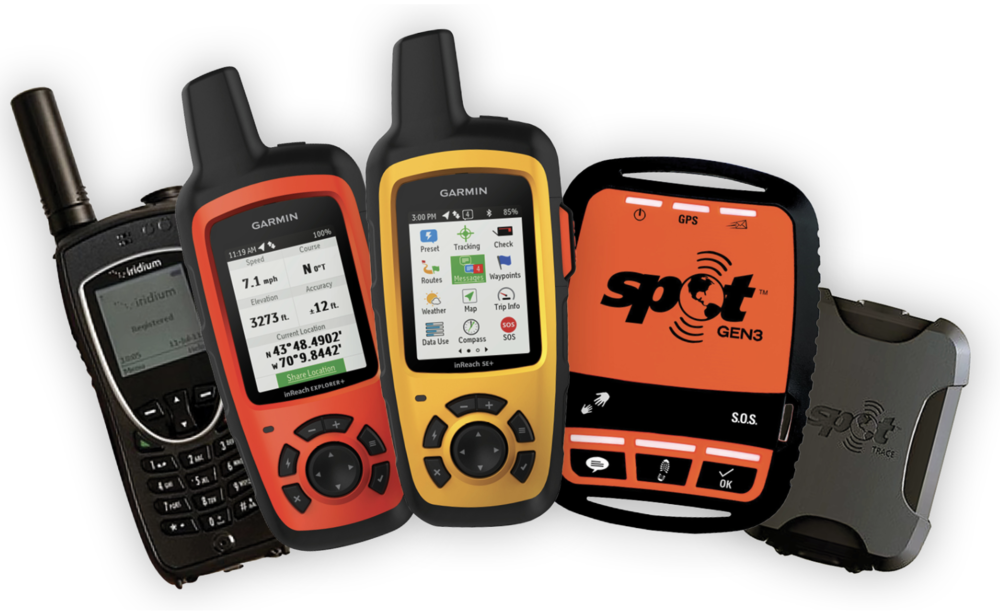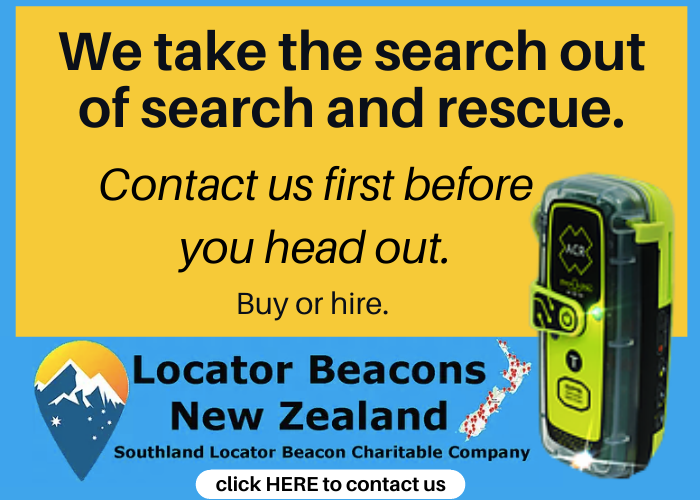Emergency devices save the day
Diana Cocks
21 January 2021, 5:04 PM
 Anyone going into the outdoors is encouraged to plan and prepare well but also carry an emergency device as a backup. PHOTO: Bradley Ramsay
Anyone going into the outdoors is encouraged to plan and prepare well but also carry an emergency device as a backup. PHOTO: Bradley RamsayTwo rescues of trampers from the local mountain ranges have featured in the news recently and both were triggered by the activation of a distress beacon or an emergency communications device.
Last week (January 15) three trampers were evacuated from Mt Aspiring National Park after triggering a satellite emergency device when one of the party experienced difficulties. Two days before that a locator beacon was activated in the high country near Mount Alta when a man on a solo mission incurred a leg injury. He was airlifted to the Wanaka Medical Centre.
Greg Johnston, a senior search and rescue officer at New Zealand’s joint rescue coordination centre (RCC), said distress beacon use has been steadily increasing year by year and the use of them has saved many lives in New Zealand.
Carrying these devices as “added insurance” is encouraged by multiple organisations, including the Mountain Safety Council, the Department of Conservation, the NZ Deerstalkers Association and by local and search and rescue (SAR) experts.
Wanaka SAR’s Alpine Cliff Rescue team coordinator Gary Dickson says whatever the activity, whether it’s mountain biking in the backcountry, or canyoning, flying, or tramping, it’s important to carry at least one emergency device during a trip.
A simple PLB or something more advanced?
The Wanaka App sat down with Gary to consider the pros and cons of emergency devices and what options are currently available.
There are several types of distress beacons and emergency communication devices with satellite/GPS tracking technology, he said, and improved technology means many are getting smaller and more capable.

Wanaka SAR’s Gary Dickson thinks the Rockstar emergency device is “awesome”. PHOTO: Wanaka App
For instance, personal locator beacons (PLBs) are simple, easy to activate, pretty rugged, have good battery life and they are lightweight. When activated they connect to the maximum number of satellites available and their signal will get out of tough communication terrain, such as a narrow gorge. They perform best when activated outside in a clear space, pinpointing your position even if you have to move because of changing conditions.
PLBs have a maximum battery life of around 10 years and can be purchased relatively cheaply (starting around $400) or hired from many different places, including DOC and Macpac. They need to be registered (a free service) with the NZRCC before use and the signal they send will get an immediate response from the RCC.
The RCC website provides good advice for purchasing or hiring a distress beacon here.
The advantage of two-way communication
Other popular emergency electronic devices are “Inreach”, “Spot” or “Rockstar 7” which not only pinpoint locations but also allow two-way communication, unlike the PLB which is a one-way only.
You can send a simple SOS, Gary said, but you can also send pre-made messages such as “Just delayed, waiting for river to go down” or “Minor injury, need assistance” which are very useful for SAR responders. Some types allow texting which is great for responders, Gary said, as they can ask questions, such as “What’s the weather like for flying?”. Others will sync with bluetooth on your mobile phone and can access a weather forecast service.

Handheld satellite devices can be as small as half a packet of cigarettes. PHOTO: Trackme.nz
Gary said these devices work on the iridium satellite network (a more limited number of satellites) but sometimes terrain, like a gorge or tight valley, can slow the signal getting out.
These devices can also be set up to leave a ‘breadcrumb’ trail to follow in the form or a GPS dot overlaid on a map on your mate’s computer screen back home. Breadcrumbs can be left at intervals from one minute to one day.
They come in various sizes and capabilities with the smallest being about half the size of a pack of cigarettes and “when every ounce counts”, as Gary said in the parlance of the 20th century, they are easy to carry.
WanakaSAR has three of the larger (bigger batteries) Rockstars “and they are awesome and very efficient”, he said.
The initial unit might start around $600-$700 but, unlike the PLBs, they do incur ongoing costs, monthly fees for subscriptions to have the distress alert monitored by a commercial operator, data plans, and so on.
For more information on hiring such devices try here.
What about satellite phones?
Satellite phones are another option but can be bulky and expensive. They’re best used in “high, big sky terrain”, Gary said, and their main advantage is two-way voice communication.
And although it might be considered old school, mountain radio can still have its place especially in the sort of terrain where you might be considering a satellite phone, Gary said. It provides two way communication via South Island base stations and usually offers a nightly radio schedule with a weather update.
“It’s good for a long-trip, especially for people who understand comms,” he said.
Selecting a device
Gary said selecting a device is a matter of choosing the right one for your personal situation. For instance, if you’re going to be rafting or kayaking, your device should float and needs to be made waterproof; if you’re likely to be in the snowline where battery life can be affected by freezing temperatures then select one with the best battery option to suit.
The Mountain Safety Council advises there’s no single device that’s perfect in every situation, so carrying two or more different devices is wise, particularly if there’s more than one in your party.
The NZRCC also recommends carrying a PLB on your person, so it doesn’t get lost if the pack goes overboard or slides down a slope.
Emergency devices as insurance
Electronic devices have been known to malfunction. “Electronics and the wide outdoors aren’t always compatible and sometimes fail,” Gary said.
And even if a device is triggered, there could be delays caused by weather or communications and rescuers might not be able to get to you straight away.
Gary said when it comes to outdoors activities, the first rule to remember is these electronic devices do not replace proper planning and sensible decision making.
“You can’t let the electronics affect your decision making. You still need to make good, sensible decisions, to keep yourself safe.”
Having said all that though, he adds, “There’s no question that we would prefer people carry them and trigger them when they feel they need to.”
The outdoors can be intimidating for the uninitiated, particularly in this region where conditions can change rapidly, and it's better to be preventative, he said.
“You can have the best intentions of doing the right thing in the backcountry but even the most experienced person can screw up, or nature throws some curveball at you, and that’s why it’s nice to carry that piece of insurance.”
Dumbing down backcountry users
Gary said the attitude that the availability of these many emergency devices is allowing people to venture further into the backcountry without taking sensible precautions was prevalent a few years ago, but “we’re gradually losing the naysayers”.
He said in the past he’s been told: “You’re dumbing down the backcountry by encouraging people to take these devices”.
But these devices are also designed to provide peace of mind for those left at home.
“The problem with this attitude is it’s usually not them we’re dealing with in an emergency, it’s their families saying ‘why aren’t you going to get them after they haven’t turned up a week later?’. And we’re left saying ‘we’d love to but they’ve made it extremely difficult to find them’”.
My usual response for people with this attitude, Gary said, is “Just carry it, you don’t have to use it. The device just sits there as this silent thing but when you need it…”
The cost of responding to a device
Triggering a device which launches a rescue operation might mean that SAR units like Gary’s get called out more often but they usually reduce the amount of time and resources which have to be committed to a search conducted with no distress beacon.
Without a device, a search for a missing person in the backcountry might occur only after that person fails to reach their destination, when next of kin contact the police, for instance. The resources required to mount a search, the manpower, the transport, the added risk in inclement weather, the extra time taken to work out search parameters, all add to “the cost”.
In contrast, a PLB triggered means the RCC immediately responds. It is New Zealand’s ultimate search and rescue specialist with a high success rate and it’s funded by the taxpayer to do this task and only this task. It directs and coordinates the resources on the ground, such as Wanaka SAR, to the location pinpointed by the beacon.
And even if it’s a false alarm it’s not a wasted trip, it’s still good training, Gary said.




